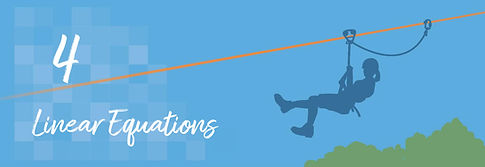
Chapter Outline
In Unit 4, “Linear Functions,” students dive into the foundational elements of linear relationships. The unit starts with an introduction to linear functions, focusing on calculating and analyzing the rate of change to determine linearity and initial values. It progresses into a thorough exploration of the slope of a line, where students identify and interpret different types of slopes in various contexts. The unit also covers the slope-intercept and point-slope forms of a line, equipping students with the skills to graph and write equations from different starting points. Additionally, it delves into writing linear equations in multiple forms and using these models to solve real-world problems. This comprehensive approach ensures a deep understanding of linear functions and their practical applications.
4.1
Slope Review
Learning Objectives
By the end of this section, you will be able to:
-
define the rate of change as the ratio that describes how one quantity changes in relation to another in a linear relationship.
-
determine the rate of change by calculating the slope of a line on a graph, using the rise over run method between two points.
-
apply the concept of rate of change to solve real-world problems involving linear relationships, such as speed, cost, and other variables that change over time.
-
interpret the significance of different rates of change within the context of various scenarios, understanding how it affects trends and predictions.
4.2
Introduction to Linear Functions
Learning Objectives
By the end of this section, you will be able to:
-
analyze the rate of change in various scenarios to determine whether a function is linear, and calculate the slope of a linear function.
-
determine if a function is continuous or discrete using a table or a graph and understand the implications of each type.
-
calculate the output values of a linear function using the function’s formula, given specific input values.
-
graph linear relationships based on real-world scenarios, like hourly earnings or sales over time, and analyze the graphical representation to draw conclusions about the relationship.
4.3
Slope of a Line
Learning Objectives
By the end of this section, you will be able to:
-
calculate the slope of a line using the rise over run method and interpret what this rate of change means in various contexts.
-
apply the concept of slope to determine the relationship between changes in dependent and independent variables across different data sets.
-
analyze graphs and tables to identify the slope and understand how it describes the relationship between variables.
-
describe the four types of slopes—positive, negative, zero, and undefined—and recognize them in equations and graphs.
4.4
Slope-Intercept Form of a Line
Learning Objectives
By the end of this section, you will be able to:
-
identify and explain the slope-intercept form of a linear equation, recognizing how it is structured as y = mx + b, where m is the slope and b is the y-intercept.
-
calculate the slope and y-intercept from a linear equation presented in slope-intercept form and understand how these components affect the graph of the line.
-
graph a linear function by identifying the slope and y-intercept from its equation, plotting the y-intercept, and using the slope to find another point.
-
analyze how changes in the slope and y-intercept values influence the position and orientation of the line on a graph.
4.5
Point-Slope Form
Learning Objectives
By the end of this section, you will be able to:
-
define and recognize the point-slope form of a linear equation and understand how it is used to represent linear functions.
-
write the equation of a line in point-slope form when given a point on the line and the slope.
-
graph a linear function by starting from a known point and using the slope to find additional points.
-
convert a linear equation from point-slope form to slope-intercept form and vice versa, applying this skill to solve real-world problems.
4.6
Writing Linear Equations
Learning Objectives
By the end of this section, you will be able to:
-
identify and use various forms of linear equations, including standard form, slope-intercept form, and point-slope form, to describe linear relationships.
-
calculate the slope using two points and write the equation of the line in both point-slope and slope-intercept forms.
-
model real-world situations with linear equations by converting verbal descriptions into mathematical forms.
-
convert linear equations from one form to another, such as from point-slope to slope-intercept form, enhancing my flexibility in handling mathematical and practical problems.